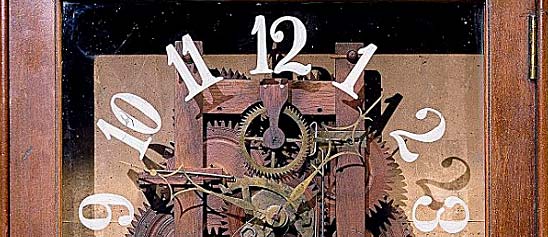This model was submitted to the U.S. Patent Office with the application for the patent issued to G. H. Babcock and S. Wilcox, Jr., of Providence, Rhode Island, April 24, 1866, no.
- Description
-
This model was submitted to the U.S. Patent Office with the application for the patent issued to G. H. Babcock and S. Wilcox, Jr., of Providence, Rhode Island, April 24, 1866, no. 54090.
-
The valve gear represented by the model is an early governable one of the class of riding cut-off valves in which the riding valve is operated by a small independent auxiliary steam cylinder, equipped with its own steam valve. The valve controlling the admission of steam to the auxiliary steam cylinder is in turn controlled by the action of the engine governor.
-
The main valve of the engine is a flat lap valve, machined top and bottom with mortises through the valve near each end. The valve functions as a common D-valve admitting steam through the mortises instead of at its ends. Solid cut-off valves working on the back of the main valve, over the mortises, are joined by a rod, which passes through a small auxiliary steam cylinder and at the middle of which within the cylinder is the small actuating piston. The valve of the auxiliary cylinder is operated transversely across the cylinder by an eccentric on the end of a lay shaft. This shaft revolves at the same speed as the crankshaft and the main-valve eccentric, but its position at any time relative to the main-valve eccentric is determined by the governor as follows:
-
The lay shaft is divided into two shafts, one driving, the other driven. The connection between the two is maintained by means of a driving bevel gear on the driving shaft, an intermediate idling bevel gear, and a driven bevel gear on the driven shaft. Though the driving and driven shafts turn in opposite directions, they turn with the same relative positions so long as the intermediate gear remains in one position. However, the axle of the intermediate fear is pivoted about the driving shaft and is held in position only by the governor rod, and the position of the intermediate gear changes with each change of position of the governor rod. A change in position of the intermediate gear advances or sets back the position of the driven shaft relative to the driving shaft and varies the action of the auxiliary steam valve relative to the action of the main-valve eccentric.
-
Reference:
-
This description comes from the 1939 Catalog of the Mechanical Collections of the Division of Engineering United States Museum Bulletin 173 by Frank A. Taylor.
- Location
-
Currently not on view
- date made
-
1866
- patent date
-
1866-04-24
- inventor
-
Babcock, George H.
-
Wilcox, Jr., Stephen
- ID Number
-
MC.308673
- catalog number
-
308673
- accession number
-
89797
- patent number
-
54,090
